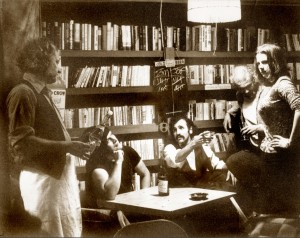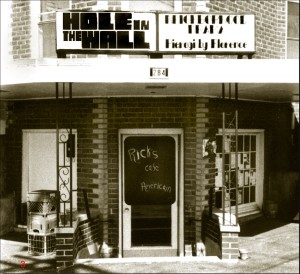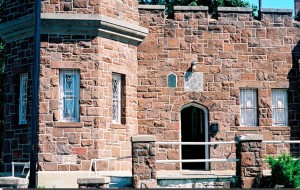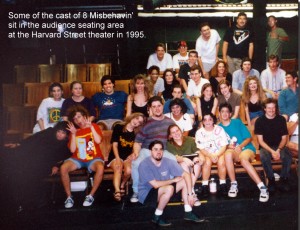The Story of Hole in the Wall
 Hole in the Wall presented the first production in its existence, The Time of Your Life, in 1972 at the bookstore of founding member Paco Robida. Located at 12 Oak Street in New Britain, the discount paperback bookstore was called, aptly enough, the “Hole in the Wall Bookstore,” thus giving rise to the theater’s unusual name. Hole in the Wall was run from its inception on a “donation” basis, with admission considered free but audience members asked to make a donation of whatever amount they chose to help keep the theater going. For the first three years of its existence, Hole in the Wall did not request a donation as the audience entered the theater. Instead, a time-honored tradition called “the pitch” was utilized, in which a member of the show asked audience members to make a donation of any size on their way out, after the show was over.
Hole in the Wall presented the first production in its existence, The Time of Your Life, in 1972 at the bookstore of founding member Paco Robida. Located at 12 Oak Street in New Britain, the discount paperback bookstore was called, aptly enough, the “Hole in the Wall Bookstore,” thus giving rise to the theater’s unusual name. Hole in the Wall was run from its inception on a “donation” basis, with admission considered free but audience members asked to make a donation of whatever amount they chose to help keep the theater going. For the first three years of its existence, Hole in the Wall did not request a donation as the audience entered the theater. Instead, a time-honored tradition called “the pitch” was utilized, in which a member of the show asked audience members to make a donation of any size on their way out, after the show was over.
It was only after the theater relocated to Arch Street in late 1975 that donations at the door were requested of incoming audience members; the original donation requested was $4.00. In the years since, it has slowly risen to our current requested $20.00 donation for a straight play and $25.00 for a musical, although the theater’s policy of accepting any size donation, or none, still survives for our Pay What You Can Performances.
Unique in its creation as well as the manner in which it was run, HITW was the only theater in the state to be run solely by its members through its biweekly gatherings, termed “General Meeting.” General Meeting is responsible for choosing the plays presented, maintaining the physical plant, and creating, revising and upholding the philosophy by which HITW was run. Anyone who walked in to a General Meeting became a fully voting member at their first meeting. From time to time, the theater would consider its donation policy and whether to keep it, go to a set ticket price, or to increase the suggested donation, but it has always functioned as a donation theater.
 After only two performances at the Oak Street location, The Time of Your Life and Spoon River Anthology, HITW moved on to 284 Allen Street and opened with The Hostage by Brendan Behan. For almost three years, September 1972 through September 1975, mounted and ran six productions per calendar year, an unusual feat for a local or community theater.
After only two performances at the Oak Street location, The Time of Your Life and Spoon River Anthology, HITW moved on to 284 Allen Street and opened with The Hostage by Brendan Behan. For almost three years, September 1972 through September 1975, mounted and ran six productions per calendar year, an unusual feat for a local or community theater.
In November of 1976, HITW again moved, this time to 50 Arch Street. Opening with William Shakespeare’s Othello, the theater remained at Arch Street until June 1978, another three year residency.
The theater’s fourth location, 121 Smalley Street, was HITW’s largest physical space, with a seating capacity of 125 and enough room for dressing room facilities, a scene shop, storage and a lobby/concession area. The rent was reasonable, but the roof leaked, so in the winter and spring of 1981-1982, theater members undertook the daunting task of repairing the roof leaks. They were so successful at their repair work that the landlord promptly doubled the rent, causing theater members to pack up their goods and move again, this time in April of 1982, to 36 North Street, their fifth home in their ten-year history.
North Street was considerably smaller than Smalley Street, with a very small makeup area, no scene shop, and only two restrooms which were shared by cast, crew and audience alike (a definite step up from Oak Street, which had one restroom for audience, cast and crew alike!). Backstage, a slop sink doubled as a dressing room sink, and a dank cinder block green room was affectionately nicknamed the “Argentine Prison” due to its lack of windows, air circulation, natural light, and the constant oozing dampness which emanated from the cement walls and, yet again, leaking roof.
shared by cast, crew and audience alike (a definite step up from Oak Street, which had one restroom for audience, cast and crew alike!). Backstage, a slop sink doubled as a dressing room sink, and a dank cinder block green room was affectionately nicknamed the “Argentine Prison” due to its lack of windows, air circulation, natural light, and the constant oozing dampness which emanated from the cement walls and, yet again, leaking roof.
HITW remained at North Street from June 1982 through June 1988, its longest period of residency in its history, and produced 36 productions in the castle-like theater. Scenery was built right on the stage due to lack of space, and cast “bathroom calls” were held just before curtain so the actors could see to their comfort before going onstage. While the theater’s productions and reputation grew in stature, the neighborhood proceeded to go downhill. Understanding that the safety of its membership and patrons was of the utmost importance, the general membership voted to relocate yet again.
In order to facilitate the relocation, the theater created a Board of Directors to oversee financial and business matters, leaving GM to deal with artistic and philosophical decisions. Throughout the late summer of 1987 and into the following summer, the Board and GM sought and located its next home, signing a lease for a former machine shop located at 10 Harvard Street.
 HITW’s next location, 10 Harvard Street, was its home from August of 1988 until July of 2003. The first production of that season, Happy Birthday, Wanda June by Kurt Vonnegut, opened in September 1988. The theater has been running steadily since that time, with six productions per season being built and performed from September through August, with an occasional showcase thrown in for good measure.
HITW’s next location, 10 Harvard Street, was its home from August of 1988 until July of 2003. The first production of that season, Happy Birthday, Wanda June by Kurt Vonnegut, opened in September 1988. The theater has been running steadily since that time, with six productions per season being built and performed from September through August, with an occasional showcase thrown in for good measure.
After searching for a new performance space for several years, Hole in the Wall moved to its current home at 116 Main Street. The location required major renovations and after much hard work by the membership, the theater opened in March of 2006 with a production of William Shakespeare’s “Merchant of Venice”. Since that time, there have been over 50 full length productions in this space.
Throughout the theater’s more than fifty year history, founding members Ray Shinn and Ted Guhl have been instrumental in the success of the theater and its longevity. Ray has directed thirty shows at Hole in the Wall, from the original production of The Time of Your Life in 1972 through to the most recent and third production of that show in September 1992, as well as having performed in numerous other productions. Ted Guhl has directed over twenty shows and has been involved in numerous other productions in some capacity or other, whether as producer, designer of costumers, sets or lights, or as an actor.
We can boast about the theater’s longevity, the creative capacity of the membership, the long-term status of many of the members, the increasingly complicated production values of current shows and our ability to live up to the challenge of meeting those values and surpassing them, but we take great pride in our humble beginnings. Hole in the Wall is truly a theater where one can take on creative risks and feel safe and supported in that venture.
